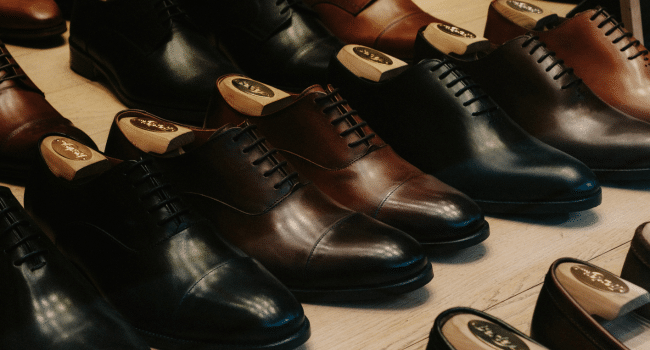Table of Contents
Dance encompasses a vast spectrum of styles, each with its unique demands on the performer. When it comes to male dancers, one of the crucial elements that can significantly influence performance quality is the choice of footwear. Selecting the ideal men’s dance shoes is not just about style; it’s also about comfort, support, and the ability to execute moves with precision. In this comprehensive guide, we will delve into the key considerations that male dancers should keep in mind when choosing dance shoes, thus ensuring their selection enhances their performance.
Understanding the Role of Dance Shoes in Performance
Dance shoes are more than just a sartorial choice. They are engineered to provide dancers with the necessary support, flexibility, and traction to perform complex manoeuvres. The right pair of shoes can prevent injuries, provide better control, and contribute to an overall tighter performance.
The Significance of Shoe Structure
One of the first aspects to consider is the structure of the shoe. Dance shoes are designed differently from your regular footwear. They often feature a reinforced arch, snug fit, and a heel with the appropriate height to accommodate the demands of specific dance styles. The structure directly impacts a dancer’s posture and alignment, which are pivotal for skilled execution of dance moves.
Fit and Comfort
It cannot be overstated how important the fit of the shoe is. Men’s dance shoes should feel like an extension of the foot, offering a secure fit without constricting movement or causing discomfort. A poorly fitted shoe can result in blisters, soreness, and even long-term foot conditions. Therefore, personal comfort is hugely important when choosing the right shoe.
Choosing Shoes Specific to the Dance Style
Different dance styles require different types of shoes. Ballet, jazz, tap, ballroom, and Latin dances all have specific footwear that enhances and supports the movements inherent in each style. It’s essential to understand the requirements of your dance genre to select the appropriate shoes.
Materials Matter
The material of dance shoes plays a critical role in both the shoe’s longevity and a dancer’s performance. Leather is a popular choice for many dance shoes due to its durability and the way it moulds to the foot over time. Canvas is another common material, particularly for ballet shoes, as it is lightweight and breathable. The choice of material can also affect flexibility and the feel of the dance floor underfoot.
Traction and Sole Composition
The sole of the shoe is another element to consider. Soles come in various materials and thicknesses, altering the amount of traction a dancer has. Suede soles are often preferred for their ability to glide across the floor while still providing enough grip to prevent slipping. It’s crucial to strike a balance between smooth movement and grip, which will vary based on personal preference and dance style.
Durability
Given the repetitive and often rigorous nature of dance, the durability of men’s dance shoes is paramount. Shoes will undergo significant wear and tear, which means selecting a pair that can withstand the pressure and not deteriorate quickly is vital for a performing artist. Good quality dance shoes are an investment that prevents frequent replacements and maintains performance standards.
Aesthetic and Design
While performance is the primary focus, the appearance of the shoes should not be neglected. Aesthetic appeal is part of the overall performance package. Ensure that the design of the shoe matches your dance attire and complements the performance style. After all, dance is also a visual art form.
Try Before You Buy
One cannot emphasise enough the importance of trying on dance shoes before making a purchase. Since the fit is so crucial to comfort and performance, it’s best to assess shoes in person, testing them with a few dance moves to ensure they fulfil your needs. Pay attention to the length and width, as well as any rubbing or discomfort while you move.
Professional Fit Advantages
Seeking help from a professional when choosing dance shoes can be a game-changer. Expert fitting services ensure that any nuances in foot shape or size are accounted for. Professionals can also advise on the best shoes for specific dance styles or performances. Don’t hesitate to ask for their assistance for optimal results.
Investing in Quality
Quality should never be compromised when it comes to dance shoes. The difference between a high-quality pair of dance shoes and a cheaper, lower-quality pair can greatly impact your ability to perform at your best. Investing in a reliable brand and sturdy materials means better support, comfort, and improved performance.
Changing Shoes for Versatility
For dancers who perform multiple styles, it may be necessary to own several pairs of shoes suited to each style. Switching shoes for different dances not only preserves the shoe but also ensures optimal performance for the specific requirements of each dance.
Maintenance to Prolong Lifespan
To keep your dance shoes in top condition, regular maintenance is necessary. This includes cleaning, storing them properly, and checking regularly for signs of wear. A well-maintained shoe will serve you better and for longer.
Final Considerations
The quest for the perfect men’s dance shoes combines a mix of practical and personal preferences. Achieving the right blend will enable dancers to elevate their performance and perfect their craft on the dance floor. Whether you’re a seasoned professional or a dedicated enthusiast, taking the time to choose the right footwear is a step towards realising your full potential as a performer.
In conclusion, remember to prioritise the fit, style-specific suitability, material, and quality of your dance shoes. Don’t underestimate the power of a good pair of men’s dance shoes – they are a dancer’s most essential tool, and with the right pair, you can truly shine in your performance.
